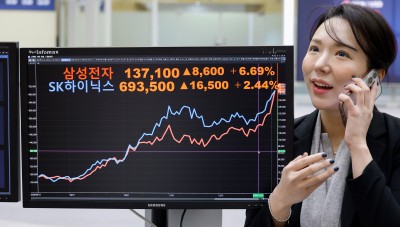To the New Perspectives on Financial Globalization Conference, International Monetary Fund, Washington, D.C.
April 26, 2007
Globalization and Financial Development
In the United States and many other countries, students learn that the key to success is hard work. Yet when we look at many developing countries, we see people who work extremely hard for long hours. Their wages are low, and so they remain poor. And as a whole, their countries remain poor. If hard work does not make a country rich, what does?
The right institutions are essential. Nobel laureate Douglass North defines institutions as the "rules of the game in a society, or, more formally, humanly devised constraints that shape human intervention." (North, 1990, p. 3). Among the institutions that are most crucial to economic growth are those that enable a country to allocate capital to its most productive uses. Such institutions establish and maintain strong property rights, an effective legal system, and a sound and efficient financial system.
In recent years, the field of economic development has come to the conclusion that "institutions rule" and are critical to economic growth.1 An extensive literature focuses on financial development as a significant force driving economic development.2
However, developing good institutions that foster financial development is not easy: It takes time for institutions to evolve and adapt to local circumstances. In addition, vested interests in poor countries often oppose the necessary reforms because they believe that such reforms will weaken their power or allow other people to cut into their profits. How can poorer countries overcome these obstacles? How can they change the distribution of power to forge the political will to promote institutional reform? The answer is globalization.
I should note that the opinions I will express today are my own and not necessarily those of my colleagues on the Federal Open Market Committee (FOMC).
Elements of Institutional Reform
Before examining the role of globalization in promoting financial development, let’s first look briefly at what steps must be taken to build an institutional infrastructure that will ensure a well-functioning financial system.
1. Develop strong property rights. Strong property rights are needed to encourage productive investment because it will not be undertaken if the returns on investment are likely to be taken away by the government or others. Hernando de Soto, in his important book The Mystery of Capital, argues that the inability of the poor in developing countries to acquire property rights is a central reason that they are unable to gain access to capital and so remain mired in poverty. For example, the use of collateral is a crucial tool that helps the financial system make loans because it reduces losses when loans go sour. A person who would pledge land or capital for a loan must, however, legally own the collateral. Unfortunately, as de Soto has documented, legalizing the ownership of capital is extremely expensive and time consuming for the poor in developing countries. In one of his many astonishing examples, obtaining legal title to a dwelling on urban land in the Philippines required taking 168 bureaucratic steps through 53 public and private agencies over a period of 13 to 25 years.
2. Strengthen the legal system. A legal system that enforces contracts quickly and fairly is an essential step in supporting strong property rights and financial development. For example, lenders write restrictive covenants into loan contracts to prevent borrowers from taking on too much risk, but such covenants have value only if they can be legally enforced. An inefficient legal system in which loan contracts cannot be enforced will prevent productive lending from taking place. If setting up legitimate businesses or obtaining legal title to property is too expensive, the poor will never have access to the legal system and will be cut off from lending that could help them start small businesses and escape poverty.3 Setting up a simple business in the United States generally requires only filling out a form and paying a nominal licensing fee. In contrast, de Soto's researchers found that legally registering a small garment workshop in Peru required 289 days; at 6 hours per day, the cost was about $1,200, which was approximately thirty times the monthly minimum wage. The lack of property rights for all but the very rich, as documented by de Soto, is a serious impediment to financial development.
3. Reduce corruption. Government is often the primary source of financial repression in developing countries. Rapacious governments whose rulers treat their countries as personal fiefdoms are not uncommon: We have seen these governments in Saddam Hussein's Iraq, Robert Mugabe's Zimbabwe, and Ferdinand Marcos's Philippines. Even officials in less tyrannical governments have been known to use the power of the state to get rich. Not surprisingly, then, many governments pay lip service to property rights but do not encourage a rule of law to protect them.
Eliminating corruption is essential to strengthening property rights and the legal system. When corrupt officials demand bribes, they reduce the incentives for entrepreneurs to make investments. The ability to buy off judges weakens the enforcement of legal contracts that enable the economic and financial system to function smoothly.4
4. Improve the quality of financial information. High-quality financial information is essential to well-functioning financial markets. If lenders cannot figure out what is going on in a firm, they will be unable to screen out good from bad credit risks or to monitor the firm to ensure that it does not take on too much risk at the lender’s expense. To make reliable and accurate information more accessible, accounting standards must be high enough so that prospective lenders can make sense of what is in a business’s books. Rules that require businesses to disclose information must be enforced to enable prospective investors to make sensible decisions about whether the business deserves to get their hard-earned money.
5. Improve corporate governance. For people to be willing to buy stocks, another way to channel funds to business, rules must be established to ensure that the managers of corporations act in the stockholders’ interest. If managers find it easy to steal from the corporation, or to use funds for their own personal use rather than for the benefit of the company, no one will want to invest in the company. Finding the right balance of control between management and stockholders is a challenge with which even we in the United States continue to struggle.
6. Develop sound, prudential regulation and supervision of the banking system. Banks are the main institutions that allocate credit in developing countries. The skills necessary for bank officers to assess risks and make good lending decisions are critically important and often scarce. Poor lending policies may cause too much capital to be channeled toward low-return projects and insufficient capital to be directed toward the high-return projects needed to propel income and growth. Moreover, deterioration in banks' balance sheets caused by insider lending or excessive risk-taking that leads to a proliferation of bad loans can cause banks to cut back sharply on lending, with negative effects on the economy. If the deterioration in banks’ balance sheets is severe enough, it can result in banking and currency crises that substantially disrupt the economy, phenomena that unfortunately have been all too common in developing countries over the past several decades.5 Preventing banking crises must start with prudential regulation, in which rules set by the government ensure that banks have sufficient capital and manage risks well. To guarantee that these regulations are enforced, the government must also engage in prudential supervision, in which it monitors banks by examining them on a regular basis to ensure that they are complying with government regulations.
The role of microfinance in developing countries is receiving much attention these days. Microfinance is a positive development; it has clearly helped substantial numbers of poor people escape poverty, and the Nobel Peace Prize awarded to Muhammad Yunus for his pioneering efforts in this area was certainly well deserved.6 However, microfinance is not a substitute for the institution building I am talking about here.
Globalizing to Advance Institutional Reform
Now that we understand what kinds of institutions are needed to promote financial development and economic growth, let’s turn to the question of how developing countries can improve the likelihood that these institutions are developed.
One of the most powerful weapons for stimulating institutional development is globalization. Wealth is not something that can be attained by remaining closed off to the rest of the world. Poorer countries would do better by embracing globalization--that is, opening their financial markets and their markets for goods and services to other nations so that funds, goods, and, often, the ideas that accompany them can flow in. Such inflows can help them achieve reforms that build productivity and wealth that will benefit all their citizens. Of course, countries need to take care that the foundations of the fundamental institutions discussed above are in place, and they must monitor the pace of reform.
Opening financial markets
Now let’s look at how opening financial markets to foreigners promotes financial development.
Globalizing the domestic financial system by opening financial markets to foreigners encourages financial development and growth in wealth in two ways. First, opening financial markets to foreign capital directly increases access to capital and lowers its cost for those with productive investments to make.7 We know that labor is cheap in poor countries, and so we might think that capital would be especially productive there. Just think of how hugely profitable a factory might be in a country where wages are one-tenth of those in the United States. Although some of that differential would likely reflect the higher productivity of American workers, capital should, nevertheless, have extremely high returns in such countries, and, in principle, we should expect substantial flows of capital from rich countries (where the returns on capital should be relatively low) to poor countries (where they should be far higher). Such capital flows could lead to substantial benefits for poor countries in the form of larger capital stocks, higher productivity, and more rapidly growing incomes.
In fact, as we well know, at present capital flows are moving, on net, from poor countries to rich ones, that is, in a direction opposite to the one we would expect. Many reasons have been proposed for this apparent paradox, but one of them certainly is the weakness of financial systems in poor countries, as described earlier. This point leads us to a second benefit of financial globalization: Opening markets to foreign financial institutions promotes reforms to the financial system that improve its functioning. Allowing foreign financial institutions to operate in an emerging-market country brings in expertise and best practices, such as those designed to screen good from bad credit risks and to monitor borrower activities to reduce the amount of risk they take.8 Because of their familiarity with more-advanced financial systems, foreign financial firms also are likely to increase the pressure on the domestic government to institute reforms that will make the financial system work more effectively.
As domestic financial institutions start to lose business to better-run and more trustworthy foreign institutions, they will realize the need for a better legal and accounting infrastructure that will make it easier for them to make loans to new customers. Domestic financial institutions will then be far more likely to advocate for and support the reforms that achieve this result.
Of course, this is not to say that in a genuinely corrupt and anticompetitive environment financial globalization, by itself, can still engender an efficient, dynamic, and modern financial system. Recent research has shown that when some countries opened up to international capital markets too soon in the absence of some basic supporting conditions, vulnerabilities to sudden stops of capital flows increased. Thus, some preconditions must exist with respect to a minimum level of institutional quality, financial market development, and macroeconomic stability before financial globalization can further improve financial market and institutional development.9 That said, given these preconditions and some constituency for progress and reform, financial globalization can be a powerful force in support of such efforts.
Opening trade in goods
Next, let’s consider how opening domestic markets to foreign goods can promote the development of better institutions.
Although not immediately obvious, opening domestic markets to foreign goods, known as "trade liberalization," can be a key driver of financial development. It can weaken the political power of entrenched business interests that might otherwise block institutional reforms, a point that is emphatically made by Rajan and Zingales (2004) in their book Saving Capitalism from the Capitalists. Trade liberalization, which promotes a more competitive environment, will lower the revenue of entrenched firms so that they will need greater access to external sources of capital. Thus, they will be more likely to support reforms that promote a deeper and more efficient financial system. In fact, research indicates that a deeper financial sector is positively associated with greater trade openness (Rajan and Zingales, 2003; Svaleryd and Vlachos, 2002).
Free trade also promotes financial deepening by reducing corruption. High tariffs breed corruption because importers have incentives to pay customs officials to look the other way when the importers avoid tariffs by smuggling in goods. Not surprisingly, countries that restrict international trade are found to be more corrupt (Ades and Di Tella, 1994).
Even when developing countries are unwilling to tear down all barriers to imports of foreign goods, they can still generate incentives for institutional reform by removing obstacles that prevent domestic producers from engaging in international trade. Facilitating production for overseas markets creates a greater need for a well-functioning financial system because, to compete effectively in the international arena, firms need better access to capital. If they can’t get capital, they won’t be able to make the investments they need to increase productivity and price their goods competitively. Accordingly, international trade creates a demand for reforms that will make the financial system more efficient.
The case of China
We are seeing how the globalization of trade is driving financial reform in China. As Chinese enterprises increasingly enter international markets, they need a better financial system that can ensure that the allocation of their high domestic savings is done efficiently and is responsive to market developments. Although it has taken time, globalization is helping to generate the demand for an improved financial system, which is driving the reform process.
The Communist leadership recognizes that the old development model must change. The government has announced that state-owned banks are being put on the path to be privatized and has allowed foreign investment in China’s banking system ($20 billion in 2005).10 The government is also engaged in legal reform to make contracts more enforceable. In August 2006, the National People’s Congress enacted a new bankruptcy law that gives creditors greater protection if a firm goes bankrupt, and last month it approved a law that gives individuals more legal protection for their property.11
China, of course, is an example of a country that has actively encouraged exports as a means of propelling its economic growth and development. To some extent, China may have gone too far in its use of policy to promote export growth. Increased reliance on market-determined prices will help ensure that the allocation of resources into the export sector does not exceed their efficient use. The goal should be to raise productivity toward world-class standards in all sectors of the economy. Recently China’s authorities have agreed that some rebalancing of the sources of growth away from exports and toward domestic demand is in order. Among China’s East Asian neighbors, the importance of developing industries to meet demand for domestic uses also is receiving increasing attention.
The problem of export restrictions
Nevertheless, developing production for exports may still be useful for those countries at the lowest rungs of the developmental ladder, and it is surprising that many of the world’s poorest developing countries still not only do not encourage an export orientation but in fact maintain a regime of taxes, restrictions, and other policies that effectively discourage it. This problem remains especially serious in some African economies and may help explain why their growth performance has been so disappointing.
The primary way that governments discourage exports is by imposing large taxes on them. Because high export taxes are one method of obtaining revenue, governments may be attracted to them to solve their budget problems. They may also use these taxes to punish their political opponents, who are often involved in a particular export industry. The government can then distribute the resulting revenue to their supporters.
The most pernicious forms of export taxes are those that are hidden through the government’s setting a fixed official exchange rate that artificially keeps the domestic currency at a value well above what it would be worth in terms of foreign currency (say, U.S. dollars) in a free market. The government then makes it illegal to sell dollars for the larger amount of domestic currency that could be obtained in the black market. The difference between the official exchange rate and the free, black-market rate (often called the "black-market premium") imposes a tax on exporters because they are forced to sell the dollars they earn to the government or to the central bank at the official rate, and thus they receive a much lower price for their goods in terms of the domestic currency.
Although in recent decades a great many countries have abandoned currency controls and dismantled their black markets, such controls still exist in some of the poorest economies, especially in Africa. In some countries, the tax from the black-market premium is confiscatory. An example from history illustrates this point. In 1982 Ghana had a black-market premium of more than 1,000 percent, and so exporters of cocoa (primarily from a tribe different from that of the ruling government party) were getting only 6 percent of the world price. Given such a high tax rate, it came as no surprise that cocoa exports, which had accounted for 19 percent of Ghana’s gross domestic product in the 1950s, accounted for only 3 percent by 1982 (Easterly, 2001, p. 222). During the twenty years when the black-market premium was so high, the average income of Ghanaians fell 30 percent.
Like many such unwarranted controls on economic life, high black-market premiums also breed corruption, with all its negative effects, because they create strong incentives to bribe officials or to smuggle goods to avoid paying the black-market-premium tax. (Indeed, one of the reasons that governments in poorer countries often use this method of taxation rather than an explicit tax is that it allows government officials to get rich from the bribes they receive.)
Other Gains from Trade Liberalization
Although we have been focusing on how globalization promotes financial development, we shouldn’t forget that trade globalization, which involves both trade liberalization and an export orientation, is a key driver of economic growth for reasons additional to those already mentioned.12
The first economics course that college students encounter always teaches the concept of comparative advantage: By trading with another country, you can focus your production on what you are really good at so that your productivity will be high. This higher productivity then leads to higher economic welfare.
Trade liberalization, more importantly, promotes competition in domestic markets, which in turn forces domestic firms to increase productivity and make better products, both of which drive economic growth. If a foreigner produces a better product that can be imported, domestic firms must make a better product at a lower price to keep selling their product at home. One graphic example of how trade promotes competition occurred in India, which up until 1991 had protected its tool industry with a 100 percent tariff (tax on imports). After the Indian government cut the tariff sharply, Taiwanese firms initially grabbed one-third of the Indian market. Over the next decade, however, Indian firms boosted their productivity almost to the levels of Taiwanese firms, thereby winning back the domestic market. Eventually Indian tool firms became so efficient that they were able to start selling their goods abroad and became substantial exporters.13
Decreasing barriers to imports also helps promote exports. Increased competition from imports lowers the profits firms can earn by focusing solely on the domestic market, and so they naturally concentrate more of their energy on exporting. Moreover, trade liberalization helps developing countries gain access to foreign markets in advanced countries, as illustrated by the fact that the United States, through free-trade agreements, has been more willing to lower tariffs for countries such as Mexico and Chile if they do the same for the United States.
Empirical evidence indicates that trade liberalization has positive effects on productivity and economic growth for both importing and exporting countries: It has even been found to be associated with more-rapid increases in life expectancy and a reduction in infant mortality.14 Yet, as is often the case in economics, empirical evidence is never completely clear cut: Some economists question whether the evidence strongly supports a positive link between trade liberalization and growth.15 Nonetheless, the logic of the benefits of trade liberalization and the preponderance of the evidence supporting its positive effects lead most members of the economics profession, including me, to the following conclusion: Trade liberalization is highly beneficial not only for the overall economy but also for its constituent sectors. The resulting economic growth is a rising tide that raises all boats and is an important tool for poverty alleviation.
But even if trade liberalization is not adopted, giving domestic producers the opportunity to sell goods to rich countries’ markets can be an important engine for growth in the world’s poorest countries. One crucial way that governments in developing countries can encourage exports is by providing the transportation infrastructure--ports, roads, and airports--that make it easier for businesses to send their goods abroad. Because foreigners don’t have a natural predilection to buy your goods, you have to be supercompetitive--your goods have to be better and cheaper than the goods made in foreign countries. Domestic firms have to focus even more on being highly productive, and boosting productivity will lead to rapid economic growth.
Japan’s experience shows what focusing on exporting can accomplish. In the immediate aftermath of World War II, Japan was a poor country. Its economic infrastructure had been destroyed by the war. To convince Americans and others to buy Japanese products, Japanese firms had to produce goods that were cheaper and better than their American-made counterparts. As a result, the export industries in Japan became enormously productive and supercompetitive. Productivity grew, and three decades after World War II, Japan became one of the richest countries in the world.
South Korea, one of the great Asian success stories even with its crisis in the late 1990s, had very high barriers to trade until the 1990s, and its early development strategy did not include opening its domestic market to foreign goods. However, through its export sector, South Korea has participated fully in global markets, and this participation has been a key to its success. South Korea’s development strategy focused on promoting its export sector, and it is the export sector that led to high productivity and economic growth. Indeed, all examples of successful growth stories in developing economies (China, Japan, South Korea, Singapore, Taiwan, Chile) have involved export sectors that met the test of international competition, and some of these economies have also pursued trade liberalization.
In almost all the industrializing East Asian economies, future growth will likely have to follow a more balanced path that relies less on exports and more on production for the domestic market. Such adjustments are needed not only to secure such economies’ further development but also to alleviate the pattern of external imbalances around the global economy. It is in the world’s poorest countries--especially in Africa and Latin America--that additional participation in global markets has the highest priority.
Only by embracing global markets can developing countries raise living standards.16 Trade liberalization has a critical role to play in economic growth by directly stimulating domestic firms to become more productive. And along with financial globalization, it can also encourage emerging-market economies to develop the institutions that foster financial development. Globalization should be one of the highest priorities for developing countries.
The Role of Advanced Countries
Can we in the advanced countries help? Yes, we can do so by supporting the opening of our markets to goods and services from emerging-market countries. By encouraging these countries to increase their participation in global markets, we create exactly the right incentives for them to implement the hard measures that will enable them to grow rich. As we have seen, exporters have strong incentives to be productive so that they can take advantage of access to our markets, and thus they will make the investments needed for growth. They also will push for the institutional reforms to make financial markets more efficient and promote financial deepening. By getting financial markets to work well, exporters will have access to the capital they need to increase their business.
Opening our markets to emerging-market countries is an important way that those in advanced countries can help emerging-market economies become successful. While providing aid to poor countries can, in the right circumstances, help eradicate poverty, it often will not work because it usually does not create the right incentives to promote economic growth. A handout is almost never as effective as a hand up.
Some are concerned about the consequences for us if we in the United States allow free competition in our markets for goods and services from countries where wages are low. Keeping many countries poor and their workers unproductive may seem to be to our benefit. But as shown in the examples of post-World War II recovery in Europe and Japan, and in the rapid growth in the 1970s and 1980s in the newly industrialized economies of Asia, higher standards of living throughout the global economy actually work to our benefit. Prosperity in our trading partners creates growing markets for U.S. exports of high-value goods. And over time, as workers’ productivity abroad rises, so will their wages and incomes. It is true that the changes brought about in our economy by globalization impose significant costs on some domestic workers. We need to develop policies to help those workers without undermining the global trading system. The costs to us of damaging that system would far outweigh the benefits that some might gain from protectionist measures. Promoting trade liberalization helps us not only do good but also do well.
References
Acemoglu, Daron, Simon Johnson, and James A. Robinson (2001). "The Colonial Origins of Comparative Development: An Empirical Investigation," American Economic Review, vol. 91 (December), pp. 1369-1401.
Acemoglu, Daron, Simon Johnson, and James A. Robinson (2005). "Institutions as the Fundamental Cause of Long-Run Growth," in Philippe Aghion and Steven N. Durlauf, eds., Handbook of Economic Growth, vol. 1, part 1. Amsterdam: North Holland, pp. 385-472.
Ades, Alberto, and Rafael Di Tella (1994). "Competition and Corruption," Institute of Economics and Statistics Discussion Paper Series 169. Oxford: University of Oxford.
Alfaro, Laura, and others (2004). "FDI and Economic Growth: The Role of Local Financial Markets," Journal of International Economics, vol. 64 (October), pp. 89-112.
Armendariz de Aghion, Beatriz, and Jonathan Morduch (2005). The Economics of Microfinance. Cambridge, Mass.: MIT Press.
Bekaert, Geert, Campbell R. Harvey and Robin L. Lumsdaine (2002). "Dating the Integration of World Equity Markets," Journal of Financial Economics, vol. 65 (August), pp. 203-47.
Bhagwati, Jagdish N. (2004). In Defense of Globalization. New York: Oxford University Press.
Bourguignon, Francois, Diane Coyle, Raquel Fernandez, Francesco Giavazzi, Dalia Marin, Kevin O’Rourke, Richard Portes, Paul Seabright, Anthony Venables, Thierry Verdier, and L. Alan Winters (2002). Making Sense of Globalization: A Guide to the Economic Issues, CEPR Policy Paper Series 8. London: Centre for Economic Policy Research, July.
Dell’Ariccia, Giovanni, and Robert Marquez (2006). "Lending Booms and Lending Standards," Journal of Finance, vol. 61 (October), pp. 2511-46.
Demirguc-Kunt, Asli, and Enrica Detragiache (2005). "Cross-Country Empirical Studies of Systemic Bank Distress: A Survey (422 KB PDF)," IMF Working Paper Series WP 05/96. Washington: International Monetary Fund, May.
de Soto, Hernando (2000). The Mystery of Capital: Why Capitalism Triumphs in the West and Fails Everywhere Else. New York: Basic Books.
Dollar, David (1992). "Outward-Oriented Developing Economies Really Do Grow More Rapidly: Evidence from 95 LDCs, 1976-1985," Economic Development and Cultural Change, vol. 40 (April), pp. 523-44.
Dollar, David, and Paul Collier (2001). Globalization, Growth, and Poverty: Building an Inclusive World Economy. New York: Oxford University Press.
Easterly, William (2001). The Elusive Quest for Growth: Economists’ Adventures and Misadventures in the Tropics. Cambridge, Mass.: MIT Press.
Easterly, William, and Ross Levine (2001). "It’s Not Factor Accumulation: Stylized Facts and Growth Models," World Bank Economic Review, vol. 15 (2), pp. 177-219.
Easterly, William, and Ross Levine (2003). "Tropics, Germs, and Crops: How Endowments Influence Economic Development," Journal of Monetary Economics, vol. 50 (January), pp. 3-39.
Edwards, Sebastian (1998). "Openness, Productivity, and Growth: What Do We Really Know?" Economic Journal, vol. 108 (March), pp. 383-98.
Eichengreen, Barry (2001). "Capital Account Liberalization: What Do Cross-Country Studies Tell Us?" World Bank Economic Review, vol. 15 (3), pp. 341-65.
Frankel, Jeffrey A., and David Romer (1999). "Does Trade Cause Growth?" American Economic Review, vol. 89 (June), pp. 379-99.
Glaeser, Edward L., Rafael La Porta, Florencio Lopez-de-Silanes, and Andrei Shleifer (2004). "Do Institutions Cause Growth?" NBER Working Paper Series 10568. Cambridge, Mass.: National Bureau of Economic Research, June.
Goldberg, Linda (2004). "Financial-Sector FDI and Host Countries: New and Old Lessons," NBER Working Paper Series 10441. Cambridge, Mass.: National Bureau of Economic Research, April.
Hall, Robert E., and Charles I. Jones (1999). "Why Do Some Countries Produce So Much More Output per Worker Than Others?" Quarterly Journal of Economics, vol. 114 (February), pp. 83-116.
Harrison, Ann (1996). "Openness and Growth: A Time-Series, Cross-Country Analysis for Developing Countries," Journal of Development Economics, vol. 48 (March), pp. 419-47.
Henry, Peter Blair (2000a). "Stock Market Liberalization, Economic Reform, and Emerging Market Equity Prices," Journal of Finance, vol. 55 (2), pp. 529-64.
Henry, Peter Blair (2000b). "Do Stock Market Liberalizations Cause Investment Booms?" Journal of Financial Economics 58 (1-2), pp. 301-34.
Jones, Benjamin F., and Benjamin A. Olken (2005). "The Anatomy of Start-Stop Growth," NBER Working Paper Series 11528. Cambridge, Mass.: National Bureau of Economic Research, July.
Kaufmann, Daniel, Aart Kray, and Pablo Zoido-Lobaton (1999). "Governance Matters," Policy Research Working Paper Series 2196. Washington: World Bank, October.
Kearl, James R., Clayne L. Pope, Gordon C. Whiting, and Larry T. Wimmer (1979). "A Confusion of Economists?" American Economic Review, vol. 69 (May, Papers and Proceedings), pp. 28-37.
Klein, Michael W. (2005). "Capital Account Liberalization: Institutional Quality and Economic Growth: Theory and Evidence," NBER Working Paper Series 11112. Cambridge, Mass.: National Bureau of Economic Research, February.
Kose, M. Ayhan, Eswar Prasad, Kenneth Rogoff, and Shang-Jin Wei (2006). "Financial Globalization: A Reappraisal (758 KB PDF)," IMF Working Paper Series WP 06/189. Washington: International Monetary Fund, August.
Lee, Ha Yan, Luca Antonio Ricci, and Roberto Rigobon (2004). "Once Again, Is Openness Good for Growth?" Journal of Development Economics, vol. 75 (December), pp. 451-72.
Levine, Ross (2004). "Finance and Growth," NBER Working Paper Series 10766. Cambridge, Mass.: National Bureau of Economic Research, September; forthcoming in Philippe Aghion and Steven N. Durlauf, eds., Handbook of Economic Growth. Amsterdam: North Holland.
Levine, Ross and Sara Zervos (1998). "Capital Control Liberalization and Stock Market Development," World Development 26, pp. 1169-84.
Mauro, Paolo (1995). "Corruption and Growth," Quarterly Journal of Economics, vol. 110 (August), pp. 681-712.
North, Douglass C. (1990). Institutions, Institutional Change, and Economic Performance. Cambridge: Cambridge University Press.
North, Douglass C., and Robert Paul Thomas (1973). The Rise of the Western World: A New Economic History. Cambridge: Cambridge University Press.
Rajan, Raghuram, and Luigi Zingales (2003). "The Great Reversals: the Politics of Financial Development in the 20th Century," Journal of Financial Economics 69 (1), pp. 5-50.
Rajan, Raghuram, and Luigi Zingales (2004). Saving Capitalism from the Capitalists: Unleashing the Power of Financial Markets to Create Wealth and Spread Opportunity. Princeton: Princeton University Press.
Rodriguez, Francisco, and Dani Rodrik (2001). "Trade Policy and Economic Growth: A Skeptic’s Guide to the Evidence," in Ben S. Bernanke and Kenneth Rogoff, eds., NBER Macroeconomics Annual 2000. Cambridge, Mass.: MIT Press.
Rodrik, Dani, Arvind Subramanian, and Francesco Trebbi (2002). "Institutions Rule: The Primacy of Institutions over Geography and Integration in Economic Development," NBER Working Paper Series 9305. Cambridge, Mass.: National Bureau of Economic Research, November.
Sachs, Jeffrey D., and Andrew M. Warner (1995). "Economic Reform and the Process of Global Integration," Brookings Papers on Economic Activity, 1995:1, pp. 1-118.
Schmukler, Sergio L. (2004). "Financial Globalization: Gain and Pain for Developing Countries (307 KB PDF)," Federal Reserve Bank of Atlanta, Economic Review, vol. 89 (Q2), pp. 39-66.
Svaleryd, Helena, and Jonas Vlachos (2002). "Markets for Risk and Openness to Trade: How Are They Related?" Journal of International Economics, vol. 57 (August), pp. 369-95.
Temple, Jonathan (1999). "The New Growth Evidence," Journal of Economic Literature, vol. 37 (March), pp. 112-56.
Wei, Shangjin (1997). "How Taxing Is Corruption on International Investors?" NBER Working Paper Series 6030. Cambridge, Mass.: National Bureau of Economic Research, May.
Weil, David N. (2005). Economic Growth. Boston: Addison-Wesley.
Winters, L. Alan, Neil McCulloch, and Andrew McKay (2004). "Trade Liberalization and Poverty: The Evidence So Far," Journal of Economic Literature, vol. 42 (March), pp. 72-115.
Wolf, Martin (2004). Why Globalization Works. New Haven: Yale University Press.
World Bank (2001). Finance for Growth: Policy Choices in a Volatile World. New York: Oxford University Press.
World Bank (2005). Doing Business in 2005: Removing Obstacles to Growth. Washington: World Bank.
Footnotes
1. A large literature shows the importance of good institutions to economic growth. See, for example, North and Thomas (1973); Hall and Jones (1999); Acemoglu, Johnson, and Robinson (2001); Easterly and Levine (2001); Rodrik, Subramanian, and Trebbi (2002); Easterly and Levine (2003); Glaeser and others (2004); and the recent survey by Acemoglu, Johnson, and Robinson (2005). Kaufmann and others (1999) also point to the importance of various aspects of good governance.
2. An excellent nontechnical survey of the extensive empirical evidence on the link between financial development and economic growth can be found in World Bank (2001). See also Levine (2004) and Schmukler (2004).
3. A discussion of how the costs of doing business vary across a number of countries is in World Bank (2005).
4. Research finds that increases in corruption are associated with lower growth (for example, Mauro, 1995). Wei (1997) also finds that corruption significantly reduces foreign direct investment, which is generally considered to be beneficial to growth.
5. A survey of the literature that links a lack of sufficient prudential regulation and supporting institutions to excessive risk-taking and the possibility of a subsequent banking crisis is in Demirguc-Kunt and Detragiache (2005). Dell’Ariccia and Marquez (2006) also argue that under certain circumstances lending booms can make the banking system more unstable and can lead to a higher probability of a banking crisis.
6. The literature on microfinance is vast. One thorough discussion is in Armendariz de Aghion and Morduch (2005).
7. When stock markets in emerging-market countries are opened to foreign capital, dividend yields fall, average stock prices increase, and liquidity goes up. See Levine and Zervos (1998); Bekaert, Harvey, and Lumsdaine (2002); and Henry (2000a,b).
8. This argument is made in World Bank (2001) and Goldberg (2004).
9. An excellent discussion of the literature on financial globalization using a unified conceptual framework is in Kose and others (2006). Studies focusing more specifically on the necessary preconditions for, and the appropriate sequencing of, financial reforms, macroeconomic policies, and institutional development, on the one hand, and capital account liberalization, on the other, include Eichengreen (2001), Alfaro and others (2004), and Klein (2005).
10. The four largest state-owned banks, with 70 percent of China’s bank deposits, are scheduled to be privatized in the following order: the Construction Bank, the Bank of China, the Industrial and Commercial Bank, and the Agricultural Bank.
11. The new law becomes effective on June 1, 2007, but reportedly will not apply to state-owned enterprises until 2008.
12. Indeed, almost all economists think that trade liberalization, a key element of globalization, is a good thing. For example, in Kearl and others (1979), 97 percent of economists agreed (generally or with some provisions) with the statement that "tariffs and import quotas reduce general economic welfare." A typical view advocating trade liberalization is expressed by Jagdish Bhagwati, one of the most prominent trade theorists in the world, in Bhagwati (2004).
13. This example comes from Weil (2005, p. 322) and is described more extensively in Dollar and Collier (2001).
14. The literature on the effects of trade liberalization on growth and poverty is immense. See the surveys in Temple (1999); Bourguignon and others (2002); Winters, McCulloch, and McKay (2004); and Wolf (2004). Earlier studies found that trade openness was associated with higher growth rates (Dollar, 1992; Sachs and Warner, 1995; and Edwards, 1998). However, because the direction of causation from this evidence is difficult to establish, other researchers have used instrumental variable procedures to establish causality from trade liberalization to growth (for example, Frankel and Romer, 1999). Using a different approach to identify the direction of causation, Lee, Ricci, and Rigobon (2004) also find that trade openness has a positive effect on growth.
15. For example, Harrison (1996) and especially Rodriguez and Rodrik (2000).
16. The finding in Jones and Olken (2005) that growth take-offs are primarily associated with large and steady expansions in international trade provides further support for this view.
























